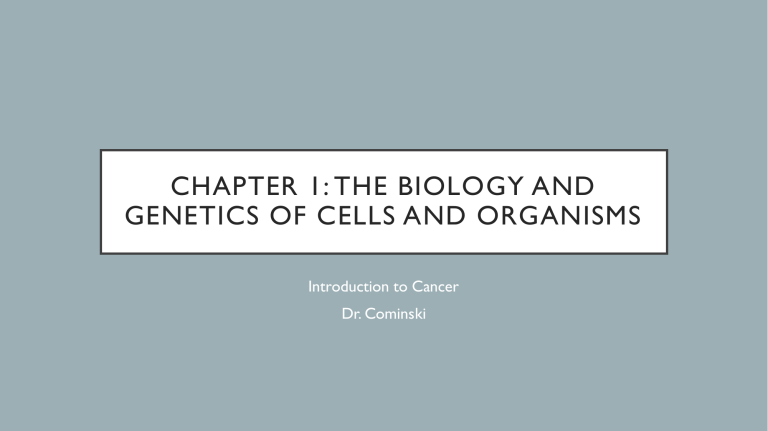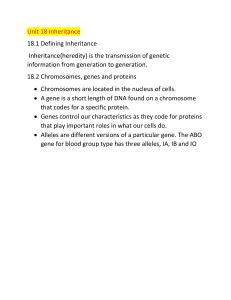
CHAPTER 1: THE BIOLOGY AND GENETICS OF CELLS AND ORGANISMS Introduction to Cancer Dr. Cominski CHARLES DARWIN AND GREGOR MENDEL • Charles Darwin – 1859, On the Origin of Species by Means of Natural Selection • What is meant by natural selection? • Darwin’s theory of evolution lacked a genetic rationale until the work of Gregor Mendel • Gregor Mendel – established the basic rules of genetics; govern how genes are passed down from one complex organisms to another • Discovered in the 1860’s using pea plants; concepts still hold true today • Mendelian Genetics • Applies to virtually all sexual organisms including metazoan (multicellular animals) and metaphyta (multicellular plants) • An organism’s genome (genetic information) – organized as a collection of discrete, separable information packets, now called genes • Humans have about 21,000 genes Charles Darwin Gregor Mendel A PARTICULATE THEORY OF INHERITANCE • Mendel – genetic content of an organism consists of discrete parcels of information, each responsible for a distinct observable trait • i.e. the heritable material for controlling the smoothness of peas behaved independently of the material governing plant height or flower color • Important Genetic Terms and Concepts • Genotype • Phenotype • Haploid vs. diploid • Allele – alternate versions of a gene • Dominant • Recessive • Co-dominant – expressed phenotype is a blend of the actions of the two alleles, i.e. pink flowers in certain plant species as a result of a white allele and a red allele • Incomplete penetrance – dominant allele may be present but its phenotype is not manifested because of the actions of other genes within the genome, i.e. certain gene mutations cause cancer, but because of incomplete penetrance, not everyone who has the mutation will develop cancer. • Heterozygotes (one wild-type (normal)/one mutant allele) THE PHENOTYPE OF AN INDIVIDUAL OFTEN DOES NOT INDICATE GENOTYPE • Heterozygotes (one wild-type (normal)/one mutant allele) • Class of alleles that predispose cells to develop cancer encode defective versions of enzymes involved in DNA repair. • Heterozygotes contain one defective copy but the normal copy functions so the defective copy is not evident • What would happen if two heterozygotes mated? What would be the chance that the offspring would inherit two defective alleles? • Draw a Punnet square to illustrate this!! MENDELIAN GENETICS HELPS EXPLAIN DARWINIAN EVOLUTION • Genetic information is corruptible = mutations • Mutations = genetic diversity • Increased diversity of the gene pool (collections of alleles present in a certain species or population) provides benefits to the species • Some alleles/mutations can be advantageous; carriers of these alleles will have a higher probability of leaving many decendents compared to individuals without these beneficial alleles • Natural selection results in continuous discarding of alleles that are not beneficial to the species and these alleles are removed from the gene pool over time • The beneficial alleles are “selected for” and remain in the species gene pool as a result of this the overall fitness of the species improves over time • The majority of DNA in our genome does not specify phenotype often is not associated with specific genes • Junk DNA = noncoding DNA (it is not really junk!!) • Only about 1.5% of mammalian DNA carries sequence information that codes for proteins MUTATIONS AND EVOLUTION Red – represents biologically important sequences; yellow – represents “junk” DNA POLYMORPHISMS • Genetic polymorphisms = inter-individual, functionally silent differences in DNA sequence that make each human genome unique • Because the great majority of the human genome does not encode biologically important information, it has evolved rapidly and has accumulated many subtle differences in sequence • Green dots indicate areas of the DNA where an alternate sequence compared to the sequence that is most common in the gene pool exist = polymorphism • Many more mutations in non-coding DNA exist in the genome because they do not affect phenotype and are therefore, not removed by natural selection • See sidebar 1.1 – Evolutionary forces dictate that certain genes are highly conserved CHROMOSOMES • Two sets of chromosomes exist in almost all cells of complex organisms = diploid • Humans = 46 chromosomes (2 sets of 23) • Autosomes vs sex chromosomes Six genes linearly arranged; different fluorescent probes A) Physical structure of Drosophila chromosomes. Notice dark and light banding and the presence of specific genetic loci Scanning electron micrograph of X and Y Chromosomes CHROMOSOMES ARE ALTERED IN MOST TYPES OF C ANCER CELLS • Euploidy – normal configuration/karyotype of chromosomes – Panel (B) below • Aneuploidy – Deviation from the normal/euploid karyotype – Panel (C) below – Pancreatic cancer cell aneuploid karyotype • In addition to extra copies of chromosomes, translocations can also occur (numerous are apparent in this pancreatic cancer cell) • Translocation – one segment of a chromosome breaks off and gets added to another A survey of nine different types of pediatric cancer indicates that each cancer type has characteristic gene amplification and deletion patterns with corresponding changes in the the expression of altered genes. Based on this graph what changes do neuroblastomas often have? Reciprocal translocation GERM-LINE VS SOMATIC MUTATIONS **Understand the difference between germline mutations and somatic mutations. **Can you identify which is which from a figure like the one here? GENES TO PHENOTYPE DNA mRNA ?? Protein ?? Phenotype Function • About 21,000 genes – only about 5% code for proteins; what is the rest of the DNA there for?? • regulatory sequences, repetitive sequences, retrotransposons, • epigenetic modifications, transcriptional activation and repression, differential expression • mRNA processing and Splicing (Figure 1.16 on next slide) • About 100,000 proteins in a cell • enzymes, synthesis, metabolism, signal transduction, receptors, cytoskeleton, • post translational modifications occur (phosphorylation, protein cleavage by proteases etc.) • Cancer can result from alterations at any of these steps, i.e. oncogenes, RNA alterations, oncoproteins, etc. • Changes in signal transduction pathways in cancer cells due to altered protein function Actin = orange; tubulin = green Processing of pre-mRNA *** proteins that specify an alternative splicing patterns have been reported to have a high expression during the transformation of a normal cell into a cancer cell Tissue specific alternative splicing patterns of ɑ-tropomyosin pre-mRNA molecule; black carets = introns; blue boxes = exons GENE EXPRESSION • What makes cells of the human body phenotypically different from one another? • Differentiation = when a cell takes on a specific phenotype • Cell becomes specified to become a certain type if tissue, i.e. brain vs. skin • All cells of the body have the same set of genes Global surveys of gene expression arrays: red = higher expression; green = lower than average expression. mRNAs from 142 different human tumors were analyzed for expression levels of 1800 different genes HOW IS GENE EXPRESSION REGULATED? • • • Transcription factors (TF) bind to regulatory regions of the DNA to either turn on transcription or turn off transcription. A single TF can affect the expression of multiple downstream responder genes = pleiotropy In cancer cells, a single malfunctioning TF may affect the expression of a large group of responder genes that together create the cancer cell phenotype. CHROMATIN AND GENE EXPRESSION • TFs and RNA polymerase also have to interact with proteins in order to gain access to the DNA and alter transcription • DNA is packaged with proteins to form chromatin POST- T R ANSL AT I ONAL MODI FI C ATI ONS OF H I STONE S AFFE CT CH ROMATI N ST RUCT UR E & T R ANSCR I P T ION • Histone modifications regulate how condensed the chromatin is, i.e. highly condensed chromatin cannot be transcribed, which results in gene repression • Modifications that lead to chromatin being less condensed activate transcription because the DNA is easily accessible to TFs and other regulators. • Methylation, acetylation, phosphorylation, etc. • These histone modifications (and others) can be passed on to daughter cells = epigenetic inheritance • This information is not part of the DNA sequence me3 = trimethylation UNCONVENTIONAL RNA MOLECULES AFFECT GENE EXPRESSION • microRNAs can control the levels of certain mRNAs in the cytoplasm and/or the efficiency of translating these mRNAs • Fig. 1.22 – miRNAs are processed post transcriptionally • Many miRNAs have been found to regulate various steps of tumor formation; either blocking or favoring critical steps of this process. • Loss of the Dicer enzyme has been associated with cancer progression.





